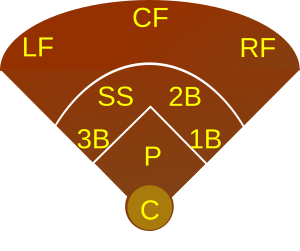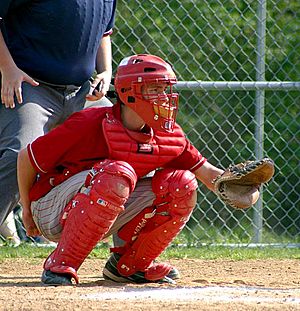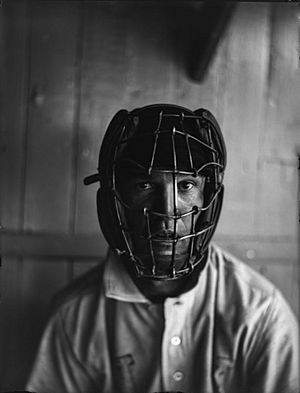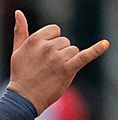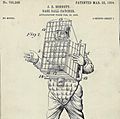Catcher facts for kids
A catcher is a special player in baseball or softball. When a batter steps up to hit, the catcher kneels behind home plate. They are in front of the umpire and catch the ball thrown by the pitcher. This is their main job, but catchers also need many other skills to play well. Their role is a bit like a wicket-keeper in cricket.
Catchers can see the whole field from their spot behind home plate. This means they are in the best position to guide their teammates during a defensive play. They often use hand signals to tell the pitcher what kind of pitch to throw. These choices depend on the pitcher's strengths and the batter's weaknesses. Catchers also handle fast foul tips, balls that bounce in the dirt, and contact with runners trying to score. Because of this, they wear special protective gear. This includes a mask, chest and throat protectors, shin guards, and a thick catcher's mitt.
Being a catcher needs a deep understanding of the game's plans. That's why many former catchers become managers in leagues like Major League Baseball. Famous examples include Connie Mack and Joe Torre. The physical and mental demands of being involved in every defensive play can make catchers tired over a long season. This can sometimes affect how well they hit the ball.
Teams often value catchers with amazing defensive skills, even if they don't hit many home runs. A smart catcher can work with the pitcher to choose the best pitches. This can make it harder for the other team to score. Some great defensive catchers, like Ray Schalk and Jim Sundberg, were not famous for their hitting. Schalk's career batting average was .253, which is the lowest for any position player in the Baseball Hall of Fame. He was chosen for the Hall of Fame in 1955 mostly because of his incredible defense. Catchers can sometimes play first base or third base too.
In baseball's scoring system, the catcher is given the number '2'. You can learn more about this in Baseball scorekeeping.
Contents
How the Catcher Position Changed
In the mid-1800s, baseball started to change from a fun game for amateurs to a serious sport played by professionals. One big change was how pitchers threw the ball. At first, pitchers threw underhand, like a basketball referee starting a jump ball. This often made batters hit easy foul pop-ups. So, catchers stood far behind the batter, about 20-25 feet away, and didn't wear any protective gear.
As the game became more professional, pitchers started throwing faster to prevent batters from hitting the ball. In 1858, the "called strike" rule was added. This meant catchers began to move closer to home plate. They had to catch the ball for a strikeout to count. Pitchers kept pushing the rules, and by the 1870s, they were throwing with their arm at waist level.
These changes made the catcher's role very important. A pitcher's tricky throws only worked if the catcher could catch them. Catchers moving closer to the plate led to new ways of pitching. In the 1870s, pitcher Candy Cummings invented the curveball. His catcher, Nat Hicks, stood close to home plate and could catch this new, tricky pitch. Other special pitches like the spitball and knuckleball followed, showing how important catchers were on defense.
Faster pitches and catchers moving closer meant more injuries, especially to their faces and hands. By the late 1870s, catchers started using padded, fingerless gloves. In 1877, the first protective catcher's mask was used. Some people questioned the courage of the first catchers to wear masks, but they worked well to prevent injuries, so everyone started using them. In the 1880s, padded chest protectors appeared. By 1888, special catcher's mitts for the non-throwing hand were common.
Around the same time, baseball teams started using a less bouncy ball, which led to fewer runs being scored. In the 1860s, it was common for teams to score 50 or 60 runs in a game! The new, harder ball and higher pitching throws led to what was called the Dead-ball era. Fewer runs meant that stolen bases and bunts became more important. This, in turn, made the catcher's defensive role even more crucial. All these rule changes and new equipment shaped the catcher's job into what it is today.
Catching Pitches Well
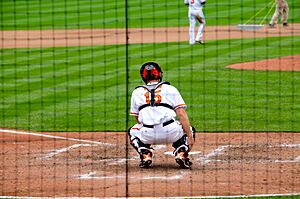
Catchers are usually the first to notice how each home-plate umpire calls the game. Some umpires like high strikes, even if they are a bit above the strike zone. Others might call low pitches strikes, even if they are below the knees. Some umpires favor pitches on the inside or outside of the plate. Catchers can use this knowledge to their team's advantage when catching the ball.
A catcher can help their pitcher get more strike calls by using a trick called "framing." This means the catcher keeps their mitt inside or very close to the strike zone when catching the pitch. This makes the pitch look like it's in the strike zone to the umpire, even if it's not perfect. When framing, a catcher will also hold their mitt still for a moment. This gives the umpire time to think and hopefully make a call that helps the catcher's team.
When catching a pitch that's on the edge of the strike zone, the catcher has choices. They can catch it in the webbing or heel of their mitt. They can also catch it on their forehand or backhand. These choices help the catcher make the pitch look good to the umpire.
A similar trick is called "pulling pitches." Here, the catcher tries to catch the half of the ball that is outside the strike zone. They then show the umpire only the part of the ball in the mitt that is closer to the zone. They might even give a slight tug of the mitt (just an inch or two) towards the strike zone to make it look better.
By rule, the catcher must be directly behind the plate (usually in the catcher's box) when a pitch is thrown. But they can move at any time to catch a pitch or make a play. If a pitcher throws an intentional ball, the catcher must have both feet in the catcher's box. The catcher is the only defensive player allowed to be in foul territory when a pitch is thrown.
Calling the Game Strategy
"Calling the game" means the catcher decides what type of pitch the pitcher should throw. Many baseball managers used to be catchers. As of As of April 2011[update], 15 out of 30 Major League Baseball managers were former catchers! Catchers are often seen as leaders on the field. They are usually in charge of planning defensive plays. The catcher gives signals to the pitcher, usually using numbers, to tell them what pitch to throw. The pitcher can agree or shake their head if they want a different pitch. These signals get more complex when a runner is on second base. This is because the runner can see the catcher's hand signals and tell the batter. Sometimes signals are done differently, like by touching parts of the chest protector.
The choice of pitch depends on many things. These include the type of batter, if there are any base runners, how many outs there are in the inning, or the current score. Traditionally, the catcher chose the pitches. However, now, the manager or a coach often signals the pitch choice to the catcher. They use secret hand signals so the other team doesn't know what's coming.
Throwing the Ball
Catchers almost always throw with their right hand. Most batters are right-handed and stand on the left side of the plate. A left-handed catcher would have to move around the batter to throw from behind the plate. Also, a lefty's throw would go towards the shortstop side of second base, while a righty's throw goes to the second base side, which is where the runner is coming. Because of this, left-handed players rarely play catcher. Only a few left-handed catchers have played in big-league games since 1902. Jack Clements is the only one to play more than 300 games as a left-handed catcher in the late 1800s. Some experts think that strong left-handed throwers are usually encouraged to become pitchers instead. Benny Distefano, the last lefty to catch a big-league game (in 1989), said that lefty catchers have trouble with bunts down the third base line and throws to home plate.
Blocking Bouncing Pitches
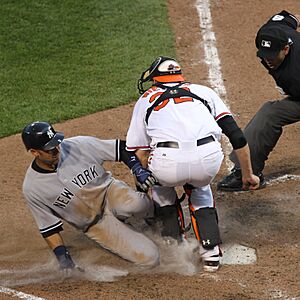
When a pitcher throws a ball that bounces towards home plate (called "in the dirt"), the catcher needs to block it. They slide their body left or right to get directly in the ball's path. Once in position, they drop to their knees and place their mitt between their legs to stop the ball from going past. They lean forward to soften the bounce if the ball hits their leg or body. Young catchers might try to catch the ball with their mitt, but coaches often teach them to "keep the ball in front of them" instead. The goal is to knock the ball to the ground so it stops close enough to pick up. To do this correctly, the catcher must lean their chest forward, towards home plate. This move can be hard, depending on how fast the ball is, how it hits the ground, and how it's spinning.
Important Defensive Plays
Unlike other fielders, the catcher and pitcher must start every play in a specific spot. The catcher must be behind home plate in the catcher's box. The pitcher must be on the pitcher's mound, touching the pitcher's rubber with one foot. But once the ball is in play, they can move anywhere on the field to help with a defensive play. Besides catching pitches and guiding the pitcher, catchers also do these important defensive plays:
- Stopping wild pitches and passed balls. Pitchers try to throw accurately, but catchers must be quick enough to catch or block bad pitches. This stops runners from moving to other bases if the ball gets loose. A bad pitch that gets past the catcher and lets a runner advance is a wild pitch. If a catcher should have easily caught or blocked a pitch but misses it, allowing a runner to advance, it's called a "passed ball."
- Catching high pop flies, which often go up at strange angles.
- Fielding softly hit ground balls (like bunts) in front of home plate. They then throw to a base to get an out. The catcher must be careful not to hit the batter-runner with the thrown ball. They need to move to a spot where they can throw clearly to first base.
- Guarding home plate when a runner tries to score. The catcher often has to catch a ball thrown from an outfielder and tag out a runner coming from third base. The runner's goal is to avoid the tag and touch the plate. Before 2014, catchers could block the runner's path. Collisions were common. Since 2014, a catcher can only block the runner's path if they have the ball. Without the ball, the catcher must let the runner score. If the catcher drops the ball while tagging the runner, the runner is safe. In youth leagues, high school, and college, runners are told to avoid big collisions.
- Stopping stolen bases by throwing to second base or third base. This lets an infielder tag out a baserunner trying to steal. A catcher who is good at this has a low stolen-base percentage. The time it takes for a catcher to get the ball from their glove to the infielder's glove at second base is called "pop time." Ideally, it should be under two seconds.
- Sometimes, a catcher can make a quick pickoff throw to a base to surprise a runner who isn't paying attention. At higher levels, this play rarely gets an out, but it makes runners take smaller leads. This gives infielders more time to throw out a runner trying to advance. Yadier Molina is known for successful pickoffs, especially at first base. Teams might also call a pitchout, where the pitcher throws the ball wide and high to the catcher. The catcher then quickly throws to a base to get a runner out.
- Rarely, a catcher will run to first or third base to help with rundown plays.
- In some game situations, like a ball hit to the shortstop or third baseman with no runners on base, the catcher might need to back up first base in case the first baseman misses a throw.
- If a runner is on first and the batter bunts or hits the ball softly, the third baseman might run in to get the ball and throw to first. In this case, the catcher must cover third base to stop the runner from first from advancing. This also means the third baseman doesn't have to cover home plate.
Any mistake by the catcher can hurt their team. Passed balls can happen whenever runners are on base. If a catcher fails to catch a ball thrown from the outfield on a play at home plate, or misses a tag, the team doesn't get an out, and the other team scores a run. On a stolen base attempt, a bad throw by the catcher might go past the infielder and into the outfield, letting the runner advance even further.
Personal Catcher Role
Because pitchers and catchers need to trust each other, some catchers become favorites of certain pitchers. This means that catcher will almost always play when that pitcher is on the mound. This catcher is often called that pitcher's personal catcher.
The tricky part is if the pitcher prefers the team's backup catcher. Then the main catcher, who is usually the better player, has to sit out. However, catchers often need rest anyway because their position is so physically tough.
Personal catchers are often used for pitchers who throw knuckleballs. These pitches are very hard to catch because they move in unpredictable ways.
Some famous personal catchers include:
- Tim McCarver, for Steve Carlton
- Bob Uecker, for knuckleballer Phil Niekro
- Charlie O'Brien and Eddie Pérez, for Greg Maddux
- Doug Mirabelli, for knuckleballer Tim Wakefield
- Josh Thole for knuckleballer R.A. Dickey
- David Ross, for Jon Lester
- Rene Rivera, for Noah Syndergaard
- José Molina, or Francisco Cervelli for AJ Burnett
Injuries Catchers Face
Being a catcher is the most physically demanding position in baseball. Even with lots of padding, catchers often get hurt. They have the risky job of blocking the plate to stop runners from scoring. Catchers also get hit by pitches, foul balls, and sometimes even the bat if the batter swings too far.
Catchers often have knee problems because of the constant crouching stance. This is why catchers are known for being slow runners. Even if they start with speed, the toll on their knees slows them down over time. There are a few exceptions, like Manny Sanguillén and Alex Avila. Some players who start as catchers move to other positions to protect their speed, play more games, and use their hitting skills. Famous examples of catchers who changed positions include Mike Napoli, Craig Biggio, and Joe Mauer.
Because of the physical demands, catchers often have shorter careers than players at other positions. This means few catchers hold batting records that take many seasons to achieve. Mike Piazza is the only catcher in history with over 400 career home runs. No catcher has reached 3,000 career hits. While 3,000 hit club member Craig Biggio played his first three full seasons as a catcher, he played his next sixteen seasons at second base and in the outfield.
Larger or heavier catchers face even greater health risks from constantly crouching. Their knees and backs are especially likely to get "wear-and-tear" injuries. Catchers also have a higher risk of blood flow problems in their catching hand. One study found that all nine catchers in a group of minor-league players had hand pain during a game, and some had long-lasting pain. Catching fast pitches can sometimes make the index finger on the gloved hand swell up. Tests showed changes in blood flow in the gloved hand of some catchers, much more than in players at other positions.
Catcher's Equipment
Catchers in baseball use special equipment to stay safe behind the plate:
- Catcher's mask: This protects the face, much of the side of the head, and often part of the throat. Lately, catchers have started wearing masks similar to those used by ice-hockey goaltenders. These "hockey-style" masks usually cover the top of the head too. Older masks were worn over a helmet (worn backward) for head protection. Some helmets are like hockey helmets, without a bill and with a face mask. These are mostly for very young players. The older style masks are now banned by the National Federation of State High School Associations.
- Mitt: Catchers use mitts with extra padding to reduce the impact of the ball on their hand. Catchers are the only players allowed to use this type of mitt. (The first baseman also wears a mitt, but it's longer and not as padded.) See Catcher's mitt.
- Shin guards: These protect the knees and legs from pitches the catcher can't catch cleanly. They also help prevent injuries from runners sliding into home plate with their metal cleats up. Most modern shin guards also have a flap that covers the top of the foot.
- Chest protector: This padded gear (with rubber, plastic foam, or gel) protects the catcher's body if they miss a pitch. Many modern chest protectors also have an extension to cover the shoulder of the non-throwing hand.
- Cup: Worn under the uniform to protect the groin area from being hit by a ball.
Some catchers also choose to use these extra items:
- Knee savers: These are special air-filled pads that attach to shin guard straps. They provide cushion for the knees when squatting, supporting knee ligaments that can stretch and tear over time.
- Inner protective glove: A glove, usually a batting glove, worn inside the mitt to help absorb the shock of the ball hitting the hand.
- Throat protector: A hard-plastic plate that hangs from the bottom of the catcher's mask to protect the throat. Since a ball hitting the throat can be very dangerous, throat protectors are required in almost all youth baseball games, even in high school.
Besides their gear, catchers also try to avoid injuries. For example, unlike other fielders, a catcher tries to catch the ball only with their gloved hand. An outfielder might cover the ball in their glove with their bare hand to secure it. But a catcher tries to keep their bare throwing hand, which is easily hurt, hidden behind their back. This way, the bare hand can't be hit by a foul tip. This simple practice helps avoid many broken fingers and other hand injuries.
Because of the physical challenges catchers face, their equipment is sometimes jokingly called "the tools of ignorance." This is funny because catchers usually have the best understanding of baseball plans and strategies on their team!
Catchers often get knee tendonitis (soreness) because of all the squatting and bending of their knees while catching.
Catchers in the Hall of Fame
Eighteen men who mainly played as catchers have been chosen for the Baseball Hall of Fame.
- Johnny Bench
- Yogi Berra
- Roger Bresnahan
- Roy Campanella
- Gary Carter
- Mickey Cochrane
- Bill Dickey
- Buck Ewing
- Rick Ferrell
- Carlton Fisk
- Josh Gibson
- Gabby Hartnett
- Ernie Lombardi
- Biz Mackey
- Mike Piazza
- Iván Rodríguez
- Louis Santop
- Ray Schalk
- Deacon White
Images for kids
See also
 In Spanish: Cácher para niños
In Spanish: Cácher para niños


